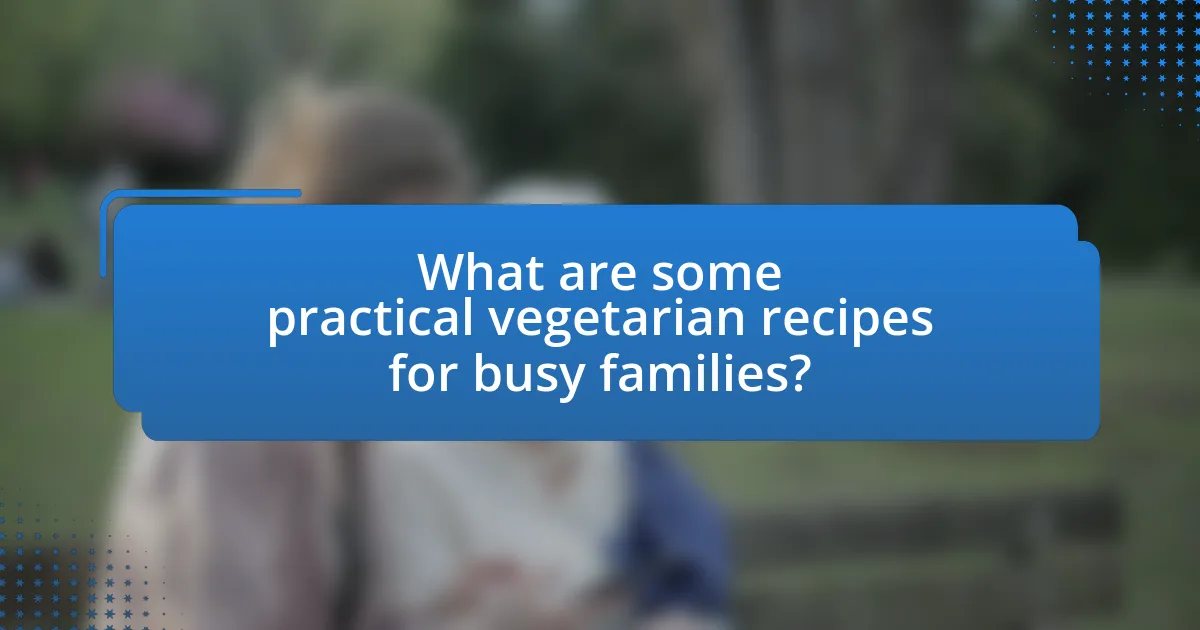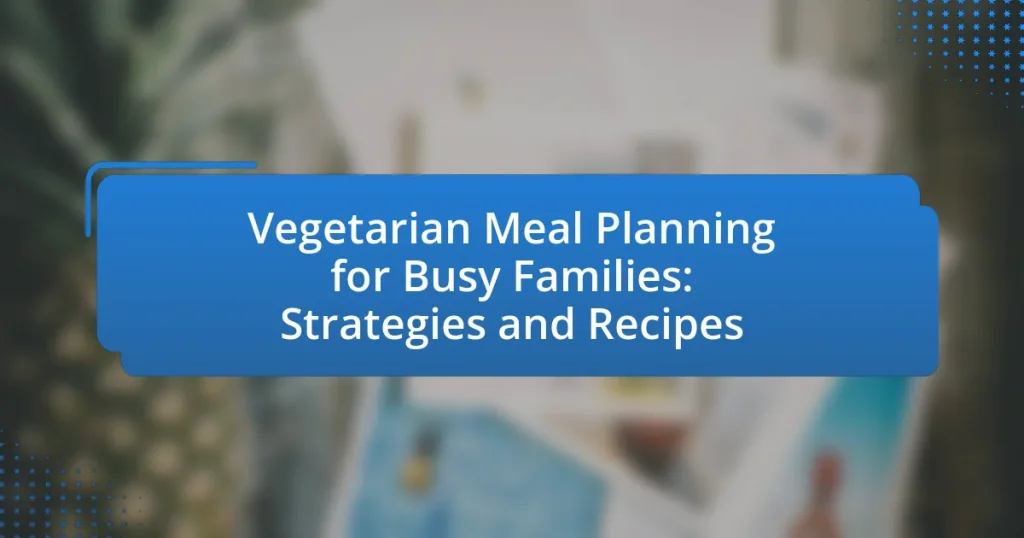Vegetarian meal planning for busy families focuses on creating nutritious, plant-based meals that can be prepared quickly to fit a hectic lifestyle. This approach emphasizes batch cooking, meal prepping, and simple recipes to save time and reduce food waste while promoting healthier eating habits. The article outlines the nutritional advantages of a vegetarian diet, strategies for effective meal planning, and practical recipes that cater to the needs of families. It also addresses common challenges faced by busy households and offers solutions to ensure variety and convenience in meal preparation.

What is Vegetarian Meal Planning for Busy Families?
Vegetarian meal planning for busy families involves creating nutritious, plant-based meal options that can be prepared quickly and efficiently to accommodate a hectic lifestyle. This approach emphasizes the use of simple recipes, batch cooking, and meal prepping to ensure that families can enjoy healthy vegetarian meals without spending excessive time in the kitchen. Research indicates that meal planning can save families time and reduce food waste, making it a practical solution for those with limited cooking time.
How can vegetarian meal planning benefit busy families?
Vegetarian meal planning can significantly benefit busy families by saving time and promoting healthier eating habits. By preparing meals in advance, families can reduce daily cooking time and minimize the stress of last-minute meal decisions. Research indicates that meal planning can lead to healthier food choices, as families are more likely to consume fruits, vegetables, and whole grains when meals are pre-planned. Additionally, a study published in the Journal of Nutrition Education and Behavior found that families who engage in meal planning tend to have better dietary quality and lower food waste, making it both a practical and sustainable approach for busy households.
What nutritional advantages does a vegetarian diet provide?
A vegetarian diet provides numerous nutritional advantages, including higher intake of dietary fiber, vitamins, and antioxidants. Research indicates that vegetarian diets are typically rich in fruits, vegetables, whole grains, nuts, and seeds, which contribute to lower risks of chronic diseases such as heart disease, hypertension, and type 2 diabetes. For instance, a study published in the Journal of the American Dietetic Association found that vegetarians have lower cholesterol levels and blood pressure compared to non-vegetarians, supporting the health benefits associated with plant-based eating. Additionally, vegetarian diets are often lower in saturated fats and calories, promoting healthier weight management.
How does meal planning save time for families?
Meal planning saves time for families by streamlining grocery shopping and meal preparation processes. When families plan their meals in advance, they can create a comprehensive shopping list that includes all necessary ingredients, reducing the frequency of grocery trips and minimizing impulse purchases. Research indicates that families who engage in meal planning can save up to 2 hours per week on meal-related tasks, as they eliminate the daily decision-making process about what to cook. Additionally, having pre-prepared meals or ingredients ready to go allows for quicker cooking times, further enhancing efficiency during busy weekdays.
What are the key principles of vegetarian meal planning?
The key principles of vegetarian meal planning include ensuring nutritional balance, incorporating a variety of food groups, and planning for convenience. Nutritional balance is achieved by including adequate sources of protein, vitamins, and minerals, such as legumes, nuts, seeds, whole grains, fruits, and vegetables. A variety of food groups helps prevent monotony and ensures a wide range of nutrients; for example, combining leafy greens with whole grains and legumes can create a complete meal. Convenience is essential for busy families, which can be addressed by preparing meals in advance, utilizing batch cooking, and selecting quick-cooking ingredients. These principles support a healthy vegetarian diet while accommodating the time constraints of family life.
How can families balance nutrition and convenience?
Families can balance nutrition and convenience by planning meals in advance and utilizing quick, healthy recipes. Meal planning allows families to select nutrient-dense vegetarian options that can be prepared in bulk, saving time during busy weekdays. Research indicates that families who engage in meal planning are more likely to consume a balanced diet, as it encourages the inclusion of fruits, vegetables, and whole grains while minimizing reliance on processed foods. Additionally, using tools like slow cookers or meal prep containers can streamline the cooking process, making it easier to maintain nutritional standards without sacrificing convenience.
What role do seasonal ingredients play in meal planning?
Seasonal ingredients play a crucial role in meal planning by enhancing flavor, nutrition, and sustainability. Utilizing ingredients that are in season ensures that meals are made with produce at its peak freshness, which often translates to better taste and higher nutrient content. For example, fruits and vegetables harvested during their natural growing season are typically more flavorful and contain more vitamins and minerals compared to those that are out of season and may have been stored for long periods. Additionally, incorporating seasonal ingredients supports local agriculture and reduces the carbon footprint associated with transporting out-of-season produce. This practice not only promotes healthier eating habits but also aligns with environmentally conscious meal planning strategies.
What challenges do busy families face in vegetarian meal planning?
Busy families face several challenges in vegetarian meal planning, primarily time constraints, limited ingredient knowledge, and balancing nutritional needs. Time constraints often lead to reliance on quick, less nutritious meals, making it difficult to prepare balanced vegetarian options. Limited knowledge about vegetarian ingredients can hinder meal variety and creativity, resulting in repetitive meals. Additionally, ensuring that all family members receive adequate nutrition, including protein, vitamins, and minerals, can complicate meal planning, especially for growing children. These challenges highlight the need for efficient strategies and resources to support busy families in adopting a vegetarian diet.
How can families overcome time constraints?
Families can overcome time constraints by implementing meal planning strategies that prioritize efficiency and organization. By dedicating a specific time each week to plan meals, families can streamline grocery shopping and cooking processes. Research indicates that meal planning can reduce food waste by up to 50% and save families an average of $1,500 annually on groceries, as noted in a study by the USDA. Additionally, preparing meals in bulk and utilizing simple, quick recipes can further minimize time spent in the kitchen, allowing families to enjoy nutritious vegetarian meals without the stress of last-minute cooking.
What strategies can help with picky eaters?
To help with picky eaters, involve them in meal planning and preparation. Engaging children in selecting and cooking vegetarian meals increases their interest in trying new foods. Research shows that children who participate in food-related activities are more likely to accept a wider variety of foods (Contento, 2007). Additionally, offering a variety of colorful fruits and vegetables can make meals more appealing, as visual presentation plays a significant role in food acceptance.

What strategies can busy families use for effective vegetarian meal planning?
Busy families can use batch cooking, meal prepping, and utilizing simple recipes for effective vegetarian meal planning. Batch cooking allows families to prepare large quantities of meals in advance, which can be stored and reheated throughout the week, saving time on busy days. Meal prepping involves organizing ingredients and planning meals ahead of time, which can streamline the cooking process and reduce decision fatigue. Simple recipes, often requiring minimal ingredients and quick cooking times, can help families maintain a vegetarian diet without extensive time commitments. Research indicates that meal planning can lead to healthier eating habits and reduced food waste, making these strategies not only efficient but also beneficial for overall family health.
How can families create a weekly meal plan?
Families can create a weekly meal plan by first determining their dietary preferences and scheduling meal times. They should list out meals for each day, ensuring a balance of nutrients and variety, while considering the time available for preparation. Utilizing a template can streamline this process, allowing families to easily visualize their meals for the week. Research indicates that meal planning can reduce food waste by up to 50% and save families an average of $1,500 annually, highlighting its effectiveness in managing both nutrition and budget.
What tools can assist in meal planning?
Meal planning can be effectively assisted by various tools such as meal planning apps, grocery list generators, and recipe websites. Meal planning apps like Mealime and Paprika allow users to create customized meal plans, generate shopping lists, and access a wide range of recipes tailored to dietary preferences. Grocery list generators streamline the shopping process by organizing ingredients based on selected recipes, ensuring that families have everything they need for their planned meals. Additionally, recipe websites provide a plethora of vegetarian options, enabling busy families to discover new dishes that fit their dietary needs and time constraints. These tools collectively enhance the efficiency and organization of meal planning, making it easier for families to maintain a vegetarian diet.
How can families involve children in meal planning?
Families can involve children in meal planning by encouraging them to choose recipes, select ingredients, and participate in grocery shopping. Engaging children in these activities fosters their interest in food and nutrition, making them more likely to try new vegetarian dishes. Research indicates that children who are involved in meal preparation are more likely to develop healthy eating habits and a positive attitude towards food. For example, a study published in the Journal of Nutrition Education and Behavior found that children who participated in cooking activities were more willing to taste and consume fruits and vegetables.
What are some time-saving cooking techniques?
Some effective time-saving cooking techniques include meal prepping, using one-pot meals, and employing kitchen gadgets like slow cookers or pressure cookers. Meal prepping allows families to prepare ingredients or entire meals in advance, significantly reducing cooking time during busy weekdays. One-pot meals simplify the cooking process by combining multiple ingredients in a single pot, minimizing cleanup and cooking time. Additionally, kitchen gadgets such as slow cookers can cook meals over several hours with minimal supervision, while pressure cookers can drastically reduce cooking times for dishes that typically take longer to prepare. These techniques not only save time but also streamline the cooking process for busy families.
How can batch cooking simplify meal preparation?
Batch cooking simplifies meal preparation by allowing individuals to prepare multiple meals at once, significantly reducing daily cooking time. This method enables families to have ready-to-eat meals available throughout the week, minimizing the need for last-minute cooking or takeout. Research indicates that batch cooking can save up to 30% of time spent on meal preparation, as families can cook in bulk and portion meals for easy access. Additionally, it promotes healthier eating habits by ensuring that nutritious meals are readily available, reducing reliance on processed foods.
What are the benefits of using a slow cooker or Instant Pot?
Using a slow cooker or Instant Pot offers significant benefits for meal preparation, particularly for busy families. These appliances save time by allowing users to prepare meals in advance and cook them slowly or quickly, depending on the method chosen. For instance, a slow cooker can simmer dishes over several hours, enhancing flavors without constant supervision, while an Instant Pot can pressure cook meals in a fraction of the time, making it ideal for quick weeknight dinners. Additionally, both appliances promote healthier cooking by requiring less oil and allowing for the use of whole ingredients, which is beneficial for vegetarian meal planning. Studies show that using these devices can lead to increased vegetable consumption, as they simplify the cooking process and encourage families to prepare homemade meals rather than resorting to takeout.
How can families ensure variety in their meals?
Families can ensure variety in their meals by incorporating a diverse range of ingredients and cooking methods. This can be achieved by planning meals that include different vegetables, grains, and proteins each week, which not only enhances flavor but also provides essential nutrients. Research indicates that a varied diet can improve overall health and reduce the risk of chronic diseases. For example, the Dietary Guidelines for Americans recommend consuming a variety of vegetables, fruits, and whole grains to meet nutritional needs. By rotating seasonal produce and experimenting with international cuisines, families can keep their meals interesting and enjoyable.
What are some creative vegetarian recipes for busy nights?
Some creative vegetarian recipes for busy nights include vegetable stir-fry, chickpea salad, and quinoa bowls. Vegetable stir-fry can be prepared in under 30 minutes using a mix of seasonal vegetables and a simple soy sauce or teriyaki glaze. Chickpea salad, made with canned chickpeas, diced cucumbers, tomatoes, and a lemon-tahini dressing, is quick to assemble and packed with protein. Quinoa bowls can be made by cooking quinoa in advance and topping it with roasted vegetables, avocado, and a drizzle of balsamic glaze, providing a nutritious meal in minimal time. These recipes are efficient and cater to the needs of busy families while ensuring a healthy vegetarian diet.
How can families incorporate international cuisines into their meal plans?
Families can incorporate international cuisines into their meal plans by exploring vegetarian recipes from various cultures and integrating them into their weekly menus. For instance, families can try dishes like Indian chickpea curry, Italian pasta primavera, or Mexican vegetable enchiladas, which are not only vegetarian but also rich in flavors and nutrients. Research shows that exposure to diverse cuisines can enhance children’s palates and encourage healthier eating habits. By selecting one international dish each week, families can gradually expand their culinary repertoire while making meal preparation more exciting and educational.

What are some practical vegetarian recipes for busy families?
Practical vegetarian recipes for busy families include vegetable stir-fry, lentil soup, and quinoa salad. Vegetable stir-fry can be prepared in under 30 minutes using a mix of fresh or frozen vegetables and tofu, providing a quick and nutritious meal. Lentil soup, which can be made in a slow cooker, offers a hearty option that is rich in protein and fiber, and can be stored for several days. Quinoa salad, made with cooked quinoa, diced vegetables, and a simple vinaigrette, is a versatile dish that can be prepared in advance and served cold or at room temperature. These recipes cater to the time constraints of busy families while ensuring a balanced vegetarian diet.
What are quick vegetarian breakfast ideas?
Quick vegetarian breakfast ideas include smoothies, overnight oats, avocado toast, and yogurt parfaits. Smoothies can be made in under five minutes by blending fruits, vegetables, and a liquid base like almond milk. Overnight oats require minimal preparation the night before, combining oats with milk or yogurt and toppings such as fruits and nuts, ready to eat in the morning. Avocado toast is prepared by mashing avocado on whole-grain bread, which takes just a few minutes, and can be topped with ingredients like tomatoes or eggs for added nutrition. Yogurt parfaits involve layering yogurt with granola and fruits, providing a balanced meal in a short time. These options are not only quick but also nutritious, making them ideal for busy families.
How can smoothies be a nutritious breakfast option?
Smoothies can be a nutritious breakfast option because they can be packed with essential vitamins, minerals, and macronutrients. By blending fruits, vegetables, and other healthy ingredients like yogurt or nut butter, smoothies provide a balanced meal that can support energy levels and overall health. For instance, a smoothie made with spinach, banana, and almond milk delivers fiber, potassium, and calcium, which are crucial for bodily functions. Additionally, studies show that incorporating fruits and vegetables into breakfast can improve nutrient intake and promote better health outcomes, making smoothies an effective choice for busy families seeking quick and healthy meal solutions.
What are some easy overnight oats recipes?
Easy overnight oats recipes include basic combinations of oats, liquid, and toppings. A simple recipe involves mixing 1/2 cup rolled oats with 1 cup almond milk, adding 1 tablespoon chia seeds, and sweetening with honey or maple syrup. For flavor, incorporate 1/2 banana and a sprinkle of cinnamon. Another variation is to combine 1/2 cup oats with 1 cup yogurt and top with berries and nuts. These recipes are quick to prepare and can be customized with various fruits, nuts, and seeds, making them ideal for busy families seeking nutritious breakfast options.
What are simple vegetarian lunch options for families?
Simple vegetarian lunch options for families include vegetable stir-fry with tofu, quinoa salad with black beans and corn, and whole grain wraps filled with hummus and assorted vegetables. These meals are quick to prepare and provide balanced nutrition. For instance, a vegetable stir-fry can be made in under 30 minutes and offers a variety of vitamins and minerals from the vegetables, while tofu adds protein. Quinoa salad is rich in protein and fiber, making it a filling option. Whole grain wraps are versatile and can be customized to include different vegetables, ensuring that families can cater to individual tastes.
How can wraps and sandwiches be made vegetarian-friendly?
Wraps and sandwiches can be made vegetarian-friendly by incorporating a variety of plant-based ingredients such as vegetables, legumes, and dairy alternatives. For instance, using hummus or avocado as spreads adds creaminess while providing healthy fats. Additionally, filling wraps and sandwiches with ingredients like roasted vegetables, fresh greens, beans, or tofu ensures a satisfying meal. According to the USDA, a diet rich in vegetables and legumes can contribute to better health outcomes, making these vegetarian options not only delicious but also nutritious.
What are some hearty salads that can be prepared in advance?
Hearty salads that can be prepared in advance include quinoa salad, chickpea salad, and pasta salad. Quinoa salad, made with cooked quinoa, black beans, corn, diced peppers, and a lime vinaigrette, holds up well in the refrigerator for several days. Chickpea salad, featuring canned chickpeas, cucumbers, tomatoes, red onion, and a lemon-tahini dressing, also maintains its flavor and texture when stored. Pasta salad, using whole grain pasta, cherry tomatoes, olives, and a balsamic dressing, can be made ahead and served cold, making it a convenient option for busy families. These salads are not only nutritious but also versatile, allowing for ingredient substitutions based on personal preferences.
What are family-friendly vegetarian dinner recipes?
Family-friendly vegetarian dinner recipes include options like vegetable stir-fry, lentil tacos, and pasta primavera. These recipes are designed to appeal to both children and adults, often incorporating familiar flavors and textures. For instance, vegetable stir-fry can be made with colorful bell peppers, broccoli, and carrots, providing essential nutrients while being visually appealing. Lentil tacos offer a protein-rich alternative to traditional meat tacos, using spices and toppings that kids enjoy. Pasta primavera combines seasonal vegetables with pasta, making it a versatile dish that can be customized based on family preferences. These recipes are not only nutritious but also quick to prepare, making them suitable for busy families.
How can pasta dishes be made vegetarian and quick to prepare?
Pasta dishes can be made vegetarian and quick to prepare by using vegetables, legumes, and pre-cooked sauces. Incorporating ingredients like spinach, cherry tomatoes, bell peppers, or zucchini can enhance flavor and nutrition while ensuring a vegetarian meal. Utilizing canned beans or lentils adds protein and can be mixed into the pasta without lengthy cooking times. Pre-made sauces, such as marinara or pesto, can significantly reduce preparation time, allowing for a meal to be ready in under 30 minutes. Studies show that meals prepared with fresh vegetables and legumes not only meet vegetarian dietary needs but also provide essential nutrients, making them a healthy choice for busy families.
What are some one-pot vegetarian meals for busy evenings?
One-pot vegetarian meals for busy evenings include dishes like vegetable stir-fry, lentil soup, and quinoa salad. These meals are quick to prepare and require minimal cleanup, making them ideal for hectic schedules. For instance, a vegetable stir-fry can be made in under 30 minutes by sautéing seasonal vegetables with soy sauce and tofu, providing a nutritious and satisfying meal. Lentil soup, which can be cooked in one pot, is rich in protein and fiber, and can be ready in about 40 minutes. Quinoa salad, combining cooked quinoa with beans, vegetables, and a simple dressing, offers a refreshing and filling option that can be prepared in advance and served cold or warm. These meals not only save time but also ensure a balanced diet for busy families.
What tips can help families maintain a successful vegetarian meal plan?
To maintain a successful vegetarian meal plan, families should focus on meal prepping, incorporating a variety of plant-based proteins, and involving all family members in the planning process. Meal prepping allows families to save time during the week by preparing meals in advance, which can lead to healthier choices and reduced food waste. Incorporating a variety of plant-based proteins, such as beans, lentils, tofu, and quinoa, ensures that families receive adequate nutrition and keeps meals interesting. Involving all family members in the planning process fosters a sense of ownership and encourages children to try new foods, which can enhance their acceptance of vegetarian meals.


